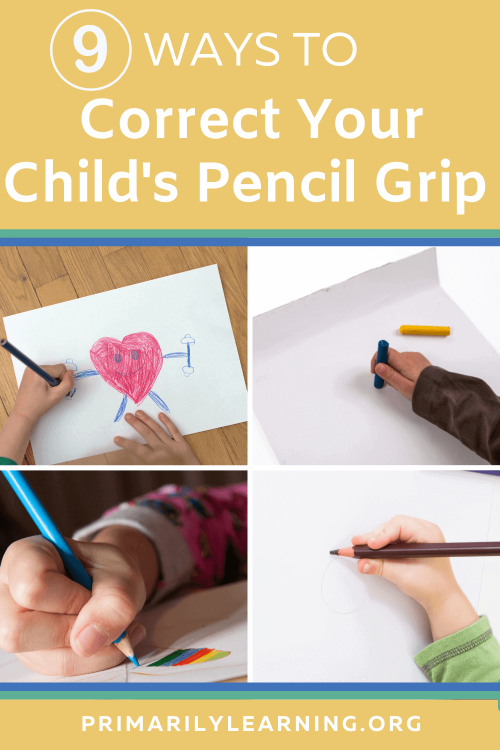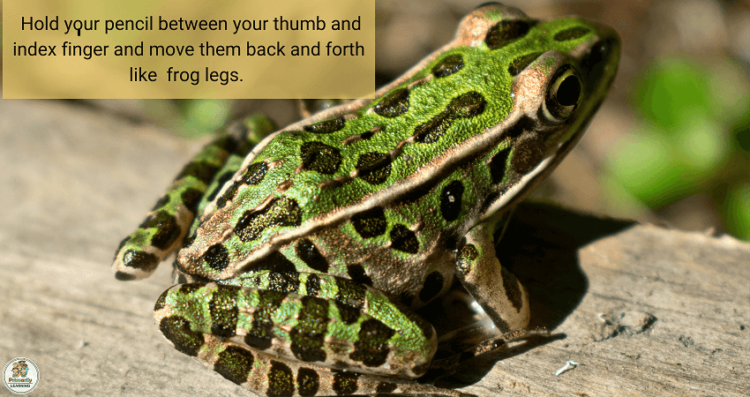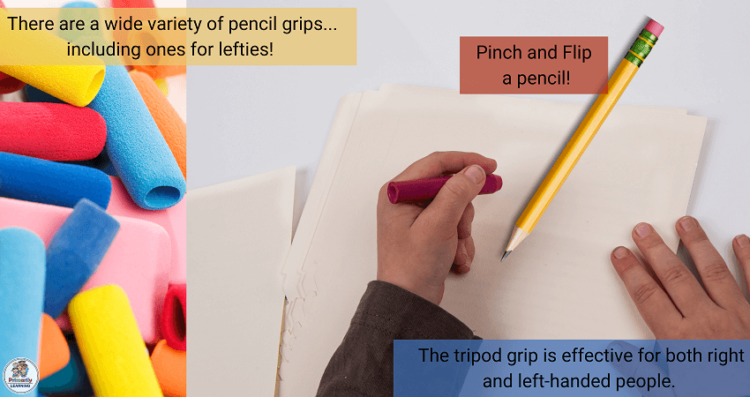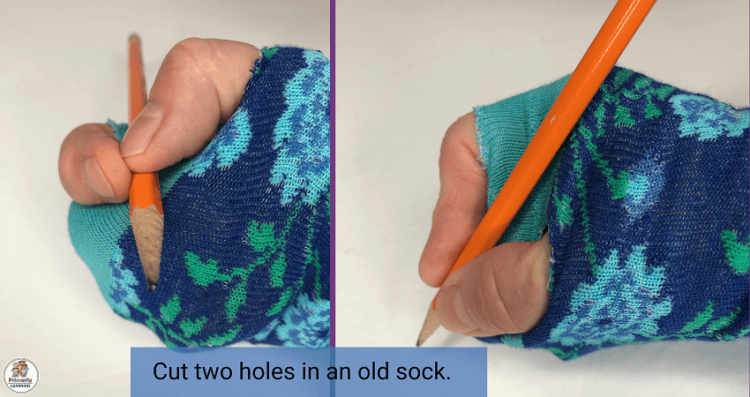Sharing is caring!


9 Ways to Correct Your Child’s Pencil Grip
How should a right or left-handed person hold the pencil?
Pencil grip varies for children and adults! Both a right and left-handed child should aim to hold the pencil with a three-finger tripod grip. Encourage a young child (aged 3-4) who is beginning to use pencils or crayons to hold the pencil between the index finger and thumb… and rest it on the middle finger. This grip becomes more automatic with practice. The writing is done by moving the fingertips.
A kindergarten teacher (children aged 4-5) will usually provide explicit instruction and practice regarding the correct pencil grip. It is important to encourage each child and provide lots of opportunities to practice this skill. The more an incorrect grip is repeated, the more ingrained it becomes; therefore, by the time the child is in grade 3, any grasp or writing habits they have formed will be difficult – if not impossible, to break. This is why early intervention is important.
What are some Common Grip Problems?
- Fist grips.
- The wrist being in an awkward position. (Keep an eye out for this with lefties!)
- Pencils that are not on an angle… likely standing tall!
- The thumb is wrapped around the top of the index finger.
- The pencil rests between the index finger and the middle finger.
- The pencil rests between the middle finger and the ring finger.
- The thumb is tucked in under the index finger.
- The pencil is gripped with all of the fingers on one side and the thumb on the other.
- The child has not learned how much pressure to apply when drawing or writing. It’s either too hard or too soft.
How Can I Help My Child Improve His Pencil Grip
1. Frog Legs
Talk about how frogs move their back legs! Ask your child to wiggle his fingers, then hide the last two fingers from the thumb by tucking them in toward the palm. Hold the pencil with the thumb and first finger. Make the knuckles move in and out just like “froggy legs.” Use the third finger as a “log” for the frog to sit on (so the pencil does not fall to the ground). This position is the same for right and left-handed people!

2. Use a Small Paperclip and a Short Pencil
If you have provided numerous and varied lessons and opportunities to improve your child's grip, but she is still resistant to change, sometimes this helps. Place a small paper clip on a short pencil. Notice the finger placement. A friend, Deb Bible, found this little verse: Here's my butterfly. She helps me write. When I hold her wings just right! Author Unknown

3. Short Pencils
Break crayons and use short pencils! Using smaller writing tools (e.g., a golfer’s pencil) encourages the child to use the correct grip because the child will hold the pencil closer to the point, and there is less surface area for a handgrip.
4. Pinch and Flip
Pinch and flip the pencil! Does this remind you of how your preschool child learned to put his jacket on? (Place the jacket on the floor, upside down. Place your hands into the sleeves of the jacket and flip it over your head!)
Lay the pencil on the table in front of the child with the pencil tip facing the child. Tell him to pick up the pencil with the thumb and index finger… pinch it! Then flip the end of the pencil back so that it rests properly at the base of the thumb… and rests on the middle finger. Kids enjoy fun tips!

5. It’s Time for PomPoms!
If the child is developmentally ready, but still using his whole hand, try placing a pompom between the last two fingers and the palm. Remember to present this activity as a fun challenge to help the child keep those fingers out of the way.
6. If all Else Fails…Try Pencil Grips
If explicit instruction and practice using the hand muscles have not helped change the grip, you may want to try one of the wide varieties of pencil grips. (Be aware that there are grips designed for lefties.) Continue to encourage the correct right or left-hand pencil grip in daily activities.
7. Hand over Hand
If your child finds the tripod grip difficult and is developmentally ready for some support, you can try hand-over-hand to help him feel the correct pencil grip. Remember to respect your child’s frustration limits. Provide explicit instruction. Encourage. Then let your child explore, experiment, and enjoy drawing and writing.

8. Sock Trick
Just for fun! Take an old sock and cut two holes in it. Have your child place the thumb and index finger through the holes as the sock is placed on the hand. The pencil rests on the middle finger, and the rest of the hand curls up for a nap!

9. Avoid Oversized Pencils and Markers
Oversize markers and pencils add variety, but imagine a young child trying to fit his small hand around a larger marker or pencil! If there is too much space between the index finger and thumb, it may confuse the child… he may feel like he doesn’t have a good grip.
Please Note: The Quadrupod Grip is Also Acceptable!
With the four-finger Quadrupod Grip, the child holds the pen or pencil with the thumb and the index and middle fingers. The crayon or pencil rests on the ring finger.
Learn More About Pencil Grip Development – from 3 months to 6 years of age.
Remember to provide explicit instruction on letter formation as the child learns letters and sounds.

Please note that the objective is to establish the best pencil grip for handwriting at an early age because handwriting is an essential tool for learning. But don’t despair… If your child is unwilling to alter their grip, they may have modified it effectively. (My daughter has an unusual pencil grip… and refused to alter it! She writes quickly, legibly, and did well in school!) For more information, check out this recent study: Effect of Pencil Grasp on the Speed and Legibility of Handwriting in Children from The American Journal of Occupational Therapy, updated April 30, 2020.
We’d love to hear about your experience! What is your pencil grip like? Were you taught how to hold a pencil in school? Did you struggle with handwriting? Did any of your children or students refuse to change their grip? Do you use a modified version of the tripod grip? Have you ever noticed how other people hold their pen or pencil?










